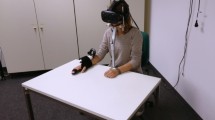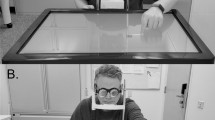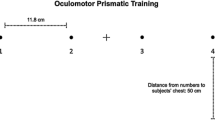Abstract
Two experiments investigated the hypothesis that the experience of manually pointing at visual targets enhances motoric adaptation to prism-displaced vision. Experiment 1 indicated that when adaptation was measured by means of redirected pointing behavior (negative aftereffect) it varied directly with the specificity of the target, the least adaptation occurring when no target was available. This relationship was not observed when adaptation was measured in terms of a shift in the felt position of the prism-exposed hand (proprioceptive shift). Experiment 2 demonstrated that after double the prism-exposure trials used in Experiment 1, target-pointing experience continued to enhance adaptation (as indexed by both types of adaptation measure). In both experiments negative aftereffect was significantly larger than proprioceptive shift for all experimental conditions and the two measures were not correlated. These latter two findings cast doubt on Harris’s notion that negative aftereffect is entirely the result of altered position sense.
Article PDF
Similar content being viewed by others
Avoid common mistakes on your manuscript.
References
COHEN, M. M. Continuous versus terminal visual feedback in prism aftereffects. Perceptual & Motor Skills, 1967, 24, 1295–1302.
COREN, S. Adaptation to prismatic displacement as a function of available information. Psychonomic Science, 1966, 4, 407–408.
HARRIS, C. S. Adaptation to displaced vision: A proprioceptive change. (Doctoral dissertation, Harvard University) Ann Arbor, Mich.: University Microfilms, 1963a, No. 63-8162.
HARRIS, C. S. Adaptation to displaced vision: Visual, motor, or proprioceptive change? Science, 1963b, 140, 812–813.
HARRIS, C. S. Proprioceptive changes underlying adaptation to visual distortions. American Psychologist, 1964, 19, 562 (Abstract).
HARRIS, C. S. Perceptual adaptation to inverted. reversed, and displaced vision. Psychological Review, 1965, 72, 419–444.
HAY, J. C., & PICK, H. L., JR. Visual and proprioceptive adaptation to optical displacement of the visual stimulus. Journal of Experimental Psychology. 1966, 71, 150–158.
HAYS, W. L.Statistics. New York: Holt, Rinehart, & Winston, Inc., 1963.
HELD, R. Exposure-history as a factor in maintaining stability of perception and coordination. Journal of Nervous & Mental Disease, 1961, 132, 26–32.
HELD, R. Adaptation to rearrangement and visual-spatial aftereffects. Psychologische Beiträge, 1962, 6, 439–450.
HELD, R. The role of movement in the origin and maintenance of visual perception. Acta Psychologica, 1964, 23, 308–309.
HELD, R., & BOSSOM, J. Neonatal deprivation and adult rearrangement: Complementary techniques for analyzing plastic sensory-motor coordinations. Journal of Comparative & Physiological Psychology, 1961, 54, 33–37.
HELD, R., & FREEDMAN, S. J. Plasticity in human sensorimotor control. Science, 1963, 142, 455–462.
HELD, R., & GOTTLIEB, N. A technique for studying adaptation to disarranged hand-eye coordination. Perceptual & Motor Skills, 1958, 8, 83–86.
HELD, R., & HEIN, A. Adaptation to disarranged hand-eye coordination contingent upon re-afferent stimulation. Perceptual & Motor Skills. 1958, 8, 87–90.
HELD, R., & MIKAELIAN, H. Motor-sensory feedback versus need in adaptation to rearrangement. Perceptual & Motor Skills, 1964, 18, 685–688.
HELD, R., & SCHLANK, M. Adaptation to disarranged eye-hand coordination in the distance-dimension. American Journal of Psychology, 1959, 72, 603–605.
HOWARD, I. P., & TEMPLETON, W. B.Human spatial orientation. New York: John Wiley and Sons, 1966.
KALLL, R. E., & FREEDMAN, S. J. Intermanual transfer of compensation for displaced vision. Perceptual & Motor Skills, 1966, 22, 123–126.
McLAUGHLIN, S. C., & WEBSTER, R. G. Changes in straight-ahead eye position during adaptation to wedge prisms. Perception & Psychophysics, 1967, 2, 37–44.
ROCK, I.The nature of perceptual adaptation. New York: Basic Books, 1966.
WALLACH, H. Informational discrepancy as a basis of perceptual adaptation. In S. J. Freedman (Ed.),The neuropsychology of spatially oriented behavior. Homewood, Ill.: The Dorsey Press, 1968. Pp. 209–229.
WALLACH, H., & KARSH, E. B. The modification of stereoscopic depth-perception and the kinetic depth-effect. American Journal of Psychology, 1963, 76, 429–435.
Author information
Authors and Affiliations
Additional information
The experiments described formed the basis of a doctoral dissertation that was completed at the University of Oregon, June, 1967. The author wishes to thank Drs. Fred Attneave, Jacob Beck, and Robert Leeper, whose suggestions and criticisms aided immeasurably in the successful completion of this dissertation.
Rights and permissions
About this article
Cite this article
Welch, R.B. Adaptation to prism-displaced vision: The importance of target-pointing. Perception & Psychophysics 5, 305–309 (1969). https://doi.org/10.3758/BF03209569
Accepted:
Issue Date:
DOI: https://doi.org/10.3758/BF03209569




